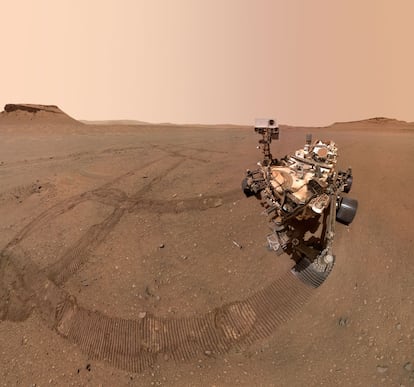NASA finds a wide variety of organic compounds in an ancient Martian lake
The Perseverance rover has detected the possible presence of key building blocks of life formed approximately 3,500 million years ago

Humanity may be one step closer to proving that there was life on Mars. The final answer depends on several rock and soil samples collected by NASA’s Perseverance Rover at Jezero Crater. This large basin, which was formed by the impact of a meteorite, was home to a huge lake from which a river flowed about 3.5 billion years ago.
Perseverance is the most ambitious mission to Mars in history, as well as the most expensive. It landed in Jezero Crater two and a half years ago, and in recent months it has been exploring the delta of the ancient river, which is now completely dry and cold. Last year, the mission already detected simple organic compounds that could be related to the presence of life in the old riverbed. The artifact stores the most interesting samples in airtight containers and leaves them on the ground for a future mission to bring them back to Earth.
Now, the mission science team has announced that they found a wide variety of more complex organic compounds that could be proof that the red planet once held life. The data comes from a spectrometer carried by Perseverance known as the SHERLOC, which detects the light emitted by different molecules in the ground. Signals compatible with a variety of organic compounds consisting of one or two rings of carbon have been detected. On Earth, these types of molecules associated with other elements such as nitrogen make up the basic building blocks of life to form, for example, the basic units of DNA.
The new data shows an unprecedented variety of these types of molecules, indicating that much more complex geochemical processes took place in the ancient river bed than previously thought. “Key building blocks for life may have been present over an extended period of time” on the surface of Mars, conclude those responsible for the work, published in the journal Nature.
However, the type of carbon compounds detected by Perseverance could also have been produced by geological processes without the presence of life, such as water-rock interactions, volcanic processes or meteorite impacts.
Joseph Razzell Hollis, co-author of the study, explains the next steps to determine the origin of those rings of carbon. “These signals are very intriguing because they could be of biological origin and, therefore, they would prove that the basic components of life could have been present on Mars for a long time [millions of years] and in several places at the same time,” he explains to EL PAÍS. “But as planetary scientists,” he adds, “we have to be very cautious; for us, the biological explanation should be the last resort, one that we will not turn to until we can rule out all possible alternative explanations.”
Jezero Crater — roughly 30 miles in diameter — was formed by a meteorite impact north of the Martian equator about 4 billion years ago. Approximately 500 million years later, the hole had filled with water and a river flowed down one of its flanks, forming deltas. NASA’s scientists estimate that this landscape survived for about 10 million years. Then Mars, which was a blue planet with seas, like Earth, began to lose all its water and atmosphere until it became the frozen desert it is today. Most experts think that if microbial life arose on Mars it could only have survived underground. In 2028, the European Space Agency (ESA) plans to send the Rosalind Franklin, a vehicle capable of drilling into the Martian surface and searching for traces of past life underground.
Finding organic compounds in Jezero has value regardless of their origin, explains Razzel Hollis. “Our results show the great variety of organic compounds that have survived on Mars despite all the time that has passed, and give us a first image of what this planet was like when it had water; just when life began to evolve on Earth,” he points out.
NASA and ESA plan to send another mission to Mars to collect the samples left behind by Perseverance with two drones, load them onto a small rocket and launch them into the planet’s orbit, where another rocket will then take them and bring them back to Earth. This pioneering mission would be completed early in the next decade. If all goes well and the samples arrive safely, it will be the moment of truth: scientists will open the airtight containers and laboratory analysis will show whether the compounds were produced by living beings billions of years ago or not.
Sign up for our weekly newsletter to get more English-language news coverage from EL PAÍS USA Edition
Tu suscripción se está usando en otro dispositivo
¿Quieres añadir otro usuario a tu suscripción?
Si continúas leyendo en este dispositivo, no se podrá leer en el otro.
FlechaTu suscripción se está usando en otro dispositivo y solo puedes acceder a EL PAÍS desde un dispositivo a la vez.
Si quieres compartir tu cuenta, cambia tu suscripción a la modalidad Premium, así podrás añadir otro usuario. Cada uno accederá con su propia cuenta de email, lo que os permitirá personalizar vuestra experiencia en EL PAÍS.
¿Tienes una suscripción de empresa? Accede aquí para contratar más cuentas.
En el caso de no saber quién está usando tu cuenta, te recomendamos cambiar tu contraseña aquí.
Si decides continuar compartiendo tu cuenta, este mensaje se mostrará en tu dispositivo y en el de la otra persona que está usando tu cuenta de forma indefinida, afectando a tu experiencia de lectura. Puedes consultar aquí los términos y condiciones de la suscripción digital.
More information
Archived In
Últimas noticias
The new victims of the Republican war on Obamacare: Millions hit by soaring health insurance premiums
A country divided on migrant rights: Some US states expand protections while others restrict them
Venezuela authorizes the release of another 87 political prisoners
There is as much life left to discover on planet Earth as that which is already known
Most viewed
- David King, chemist: ‘There are scientists studying how to cool the planet; nobody should stop these experiments from happening’
- Reinhard Genzel, Nobel laureate in physics: ‘One-minute videos will never give you the truth’
- Oona Chaplin: ‘I told James Cameron that I was living in a treehouse and starting a permaculture project with a friend’
- Sinaloa Cartel war is taking its toll on Los Chapitos
- The Interoceanic Train, the Mexican alternative to the Panama Canal











































